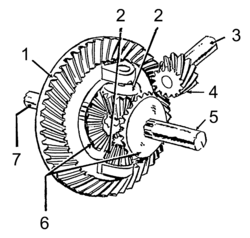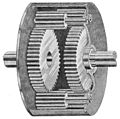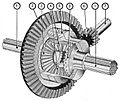Differential (mechanical device) facts for kids
A differential is a clever mechanical device found in most cars and trucks. It's made up of several gears and helps send power from the engine to the wheels. Its main job is to let the drive wheels spin at different speeds. This is super important when a vehicle goes around a corner, because the outer wheel has to travel a longer distance than the inner wheel. The differential makes sure both wheels still get power from the engine, even when they're turning at different speeds. Without it, turning would be very difficult, and the tires would drag!

Contents
Types of Differentials
There are a few different kinds of differentials, each with its own way of working.
Open Differential
An open differential (often called an OD) is the most common type. It's also usually the cheapest.
- How it works: An open differential lets a vehicle go around corners smoothly. It stops the outside wheel from dragging.
- The challenge: The problem is that an open differential sends power to the wheel that has the least amount of grip on the road. If one wheel is on ice or a slippery surface, it will just spin. The vehicle won't move forward because all the power goes to that spinning wheel.
- In different vehicles: In vehicles with two-wheel drive, if they have an open differential, it's like only one wheel is actually pushing the vehicle forward. In four-wheel drive vehicles with open differentials, only one wheel on each axle provides power.
- Good points: They rarely break an axle, cause less tire wear, and are common in new vehicles.
Limited Slip Differential
A limited slip differential (LSD) helps solve the problem of the open differential.
- How it works: An LSD uses special clutches inside. It allows a small amount of wheel slippage but still sends power to both drive wheels. This means if one wheel starts to slip, the other wheel still gets power.
- Where it's used: LSDs are popular in race cars. This is because race cars often need to accelerate quickly when coming out of turns without losing power to one wheel.
Locking Differential
A locking differential (or "locker") can "lock" the two drive wheels on an axle together.
- How it works: When locked, both wheels on that axle turn at exactly the same speed. This is great because both wheels always have power.
- The challenge: Turning is much harder with a locker engaged. Since both wheels must turn at the same speed, they can't easily go around corners. Because of this, most lockers need to be turned off when making sharp turns.
- Safety note: Lockers can also create tricky situations. For example, if you're driving sideways on a slope and one wheel loses grip, both wheels might lose grip. This could cause the vehicle to slide sideways down the slope. Drivers are often warned not to use lockers on loose or slippery slopes.
- How they're controlled: Lockers can be switched on or off in different ways: mechanically, electronically (called an e-locker), or using compressed air (called an air locker).
- Best use: Lockers are very useful for off-road vehicles. However, they are usually not helpful for driving on regular streets and highways.
Spool
A spool is a simple type of differential where the axles are permanently joined together.
- How it works: With a spool, neither wheel can go faster or slower than the other when turning corners. They are always locked together.
- Good points: Spools are cheap and don't add much weight to the vehicle.
- The challenge: They are usually only used for off-road competitions and trail driving. They are not good for driving on regular streets because they will make the tires "chirp" or squeal when going around corners.
Images for kids
-
A cutaway drawing of a car's rear axle, showing the gears of the final drive and the smaller differential gears.
-
A differential used to control the take-up reel of a paper tape reader from around 1962.
See also
 In Spanish: Mecanismo diferencial para niños
In Spanish: Mecanismo diferencial para niños









